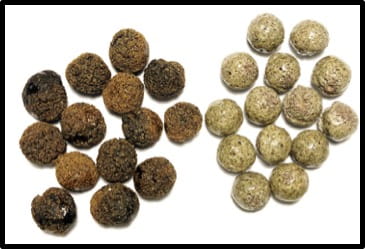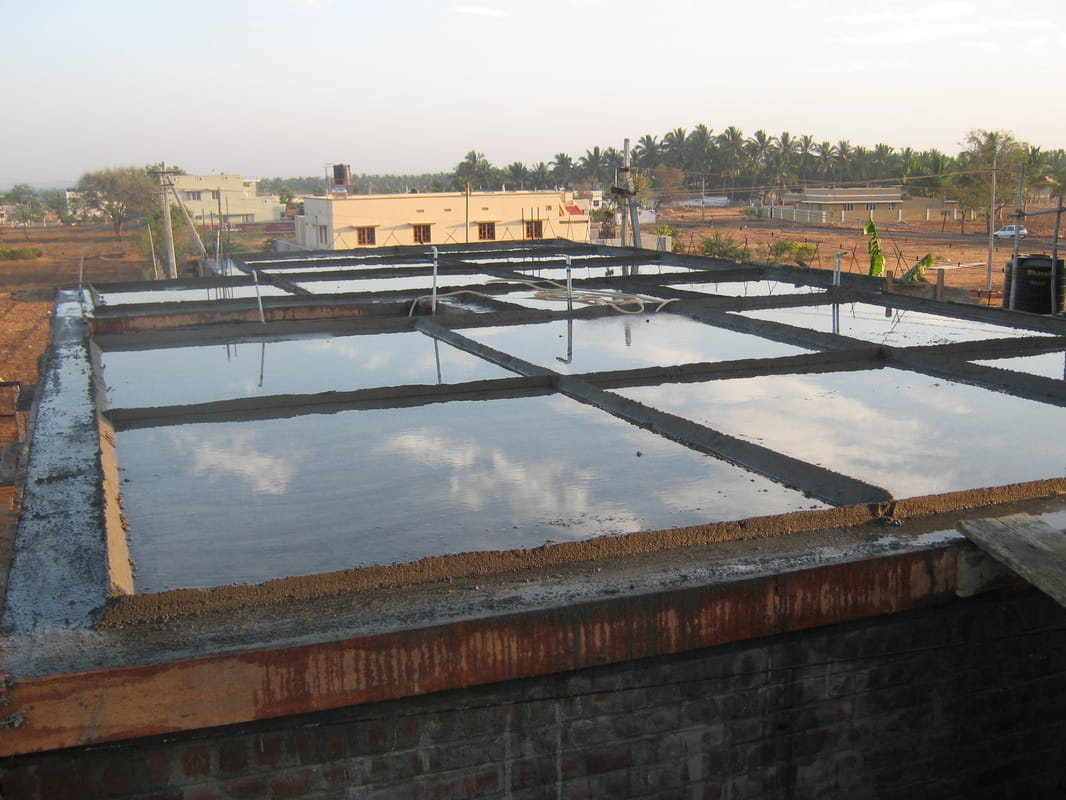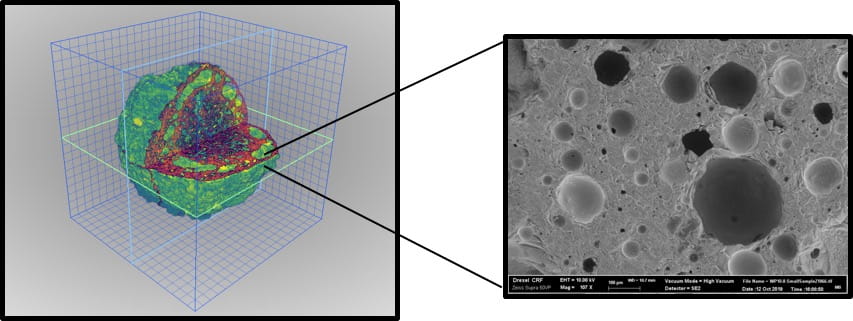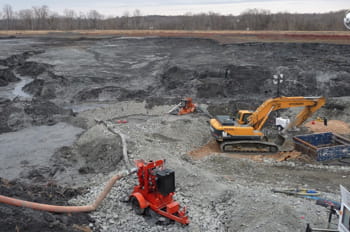Ashes to Concrete

- Drexel Selects New, World-Class Life Sciences Building at 3201 Cuthbert Street for Medical Research Operations
- Breakthrough on Gene Therapy for Hereditary Spastic Paraplegia
- Drexel Environmental Collaboratory Releases Cross-Sector Findings on Severe Weather Recovery Challenges
- Drexel Launches the Manuel Stamatakis Center for Alternative Investments at the LeBow College of Business

Drexel researchers are recycling coal ash, a waste product from coal power plants, to make a porous, lightweight aggregate that can be used as a concrete additive to aid the hardening process.
Coal ash is the less notorious byproduct of coal-fired power plants. It’s the residual solid waste that comes from burning coal. While it doesn’t have the same deleterious reputation of its airborne counterparts, tens of millions of tons of ash does end up in landfills each year. Now researchers from Drexel University believe they have found a use for the powdery residue — one that could help make concrete more durable and crack-free.
Recently reported in the journal Cement and Concrete Composites, their discovery is a method for turning waste ash into a special concrete additive that helps to fortify its internal structure by promoting a uniform hardening process from the inside out. This additive — a high-performing, functional aggregate — could shorten the time it takes for concrete to harden and improve its durability by lowering the potential for crack formation, according to the researchers.
Just the Right Mix
Concrete is made from a mixture of fine powder and coarse rock particles, called aggregates, bonded by a mineral glue called a “cementing matrix,” made of cement and water. The aggregates form the strong internal structure of the concrete as the cementing matrix hardens to bind the ingredients together in a process called curing. For concrete to reach its maximum durability, the cement must mix thoroughly with water during the curing process so it all dries — and cures — at the same time.
“This is a very important part of the process because if the concrete dries too quickly during its curing, due to added water shortage, it can form cracks and other flaws. These drying shrinkage cracks cause the surface to be susceptible to aggressive fluid ingress creating concrete durability problems such as corrosion, salt damage, or freeze-thaw damage,” said Yaghoob Farnam, PhD, an assistant professor in Drexel’s College of Engineering and principle investigator of the research.

To ensure even curing there are a number of things concrete contractors might have to do, including constantly spraying the concrete, covering it with a membrane to keep it moist, submerging it in water or creating pools of water on its surface. All of these strategies consume time and resources and are complex enough that flaws could creep into the process. To help prevent this, in the last decade researchers have developed an internal curing concept that uses porous lightweight aggregate to aid the curing process. The aggregate can maintain a consistent level of moisture inside the concrete to help it cure evenly from the inside out.
“The use of a high-performance lightweight aggregate in concrete can be a solution to properly provide sufficient water reservoirs inside concrete as water is needed over time for curing cementitious matrix,” Farnam said.
Working with Concrete is Hard
Concrete is one of the most widely used building materials in the world. It’s the material of choice for most new high-volume roads, buildings, bridges and many other structures because of its durability and relative ease of application.
But one drawback to using concrete is that it requires just the right atmospheric conditions to allow proper mixing and even curing — not too hot, not too cold, not too dry.
Getting the exact amount of moisture inside concrete is difficult because the powder and aggregates form a tight cementing matrix that is difficult to penetrate once it begins drying. If the outside of the concrete dries out before the inside cures it can result in a weaker structure. As a result, contractors basically have one shot to get the ratio of liquid to solid just right, quickly and thoroughly mix it and pour the concrete before it starts drying.
“This is a common problem in concrete, so called ‘concrete drying,’ creates drying cracks and lower concrete strength and durability,” said Mohammad Balapour, a doctoral researcher in Farnam’s lab and lead author of the paper.
Finding a Cure
To give contractors more leeway in the process, Farnam’s team, in collaboration with faculty members in the Drexel’s Civil, Architectural, and Environmental Engineering Department, Grace Hsuan, PhD, and Sabrina Spatari, PhD, as well as E.J. Garboczi, PhD, from National Institute of Standards and Technology, looked at how functional lightweight aggregates can be developed from coal ash and used in concrete.
The concrete industry has limited access to natural or synthetic lightweight aggregates, according to Farnam, because of its dependency on limited sources of aggregate material. Farnam’s lab wanted to design an aggregate product that had optimal characteristics for mixing, strength and porousness — and find a way to make it out of an abundant waste material.
“The solution we came up with involved recycling this waste product, coal ash, into a porous, lightweight aggregate with excellent performance characteristics that could be produced at a lower cost than current natural and synthetic options,” Farnam said. “This material and process would not only benefit the concrete industry by improving the quality of their products, but it could also help keep coal ash out of landfills.”

The material they came up with is called “spherical porous reactive aggregate” — SPoRA, for short. It is made by combining the ash with chemicals that facilitate aggregate sintering and bonding, forming them into tiny spheres and then baking them at 1,160 degrees Celsius for a few minutes.
The end product is an aggregate pellet that can hold almost half its weight in water, which is better than traditional lightweight aggregates. And, as importantly, it can release that water at a regular rate from inside to the cementing matrix as it cures.
In the paper they report that two types of SPoRA perform better than some traditional lightweight aggregate materials — shale, clay and slate, and foamed glass — on measurements of shape, porousness, relative weight and ability to absorb and release water. These are all key metrics related to its ability to integrate with the cement mixture and release its moisture at the right time and in the right part of the structure as it forms.
“As the concrete begins to cure on the outside, the aggregate pellets are also releasing their moisture to help it cure from the inside out as well,” Balapour said. “This approach can help to maximize the durability of the concrete. And the SPoRA-making process is simple enough to produce aggregates of any size and water capacity, so we believe it could be used for a number of applications in the construction industry.”

Recycling a waste product like coal ash not only reduces the cost of making lightweight aggregate, but it also ensures that concrete producers will have access to it.
“Taking something that is a waste product — with mountains of it in landfills — and turning it into a useful product is an excellent example of how science can help to find sustainable solutions to society’s challenges,” Farnam said. “Not only does this help protect our natural environment but will also help to improve our built environment.”
In addition to Farnam, Balapour, Hsuan, Spatari and Garboczi, Weijin Zhao and Nay Ye Oo, from Drexel; and Pieter Billen, from the University of Antwerp assisted with this research. The research was funded by the National Science Foundation.
Read the full paper here: https://www.sciencedirect.com/science/article/pii/S0958946519301593
Drexel News is produced by
University Marketing and Communications.